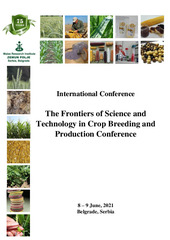Приказ основних података о документу
Optimization of the doubled haploid technology for temperate maize breeding programs: a case study from Maize Research Institute Zemun Polje
| dc.creator | Božinović, Sofija | |
| dc.creator | Nikolić, Ana | |
| dc.creator | Djordjevic Melnik, Olivera | |
| dc.creator | Pavlov, Jovan | |
| dc.creator | Čamdžija, Zoran | |
| dc.creator | Grčić, Nikola | |
| dc.creator | Vančetović, Jelena | |
| dc.date.accessioned | 2023-11-06T08:21:12Z | |
| dc.date.available | 2023-11-06T08:21:12Z | |
| dc.date.issued | 2021 | |
| dc.identifier.isbn | 978-86-80383-12-5 | |
| dc.identifier.uri | http://rik.mrizp.rs/handle/123456789/1240 | |
| dc.description.abstract | Doubled haploid (DH) technology is one of the several technological advances greatly impacting modern maize breeding. The main benefit for breeders is the development of parental inbred lines in one year comparing to four using conventional breeding. Maize Research Institute Zemun Polje (MRIZP) initiated doubled haploid program in maize in 2014. In six years up to 8.000 DH lines have been developed from close to 160 donor germplasm sources of different genetic backgrounds. During this period the research group engaged in the DH program identified several issues that need to be addressed in order to optimize the method for use in temperate regions including poor agronomic performance of haploid inducing lines, donor germplasm effect on the overall efficiency of DH method in maize breeding and selection strategies for improving test-cross performance of DH lines. To meet the challenges, MRIZP DH research group started a breeding program aiming at developing inducers with high and stable HIR adapted to temperate climate conditions. Two main goals were defined: development of haploid inducers with HIR up to 20% in a completely inducer genetic background, and second, to develop haploid inducers in 75 and 50% inducer genetic background with moderate HIR but better agronomic performance. Also, nine populations were used to assess the suitability of our most elite breeding materials for use as donors with respect to genetic background, specifically heterotic group origin, and give guidance to breeders on donor germplasm selection. Furthermore, we are studying different selection strategies for DH line breeding with respect to donor size and prior cycles of selection, i.e. recombination (none (F1), one (F2), or two selection cycles (F3)). We hope that our still ongoing research will contribute to already extensive knowledge on doubled haploid methodology. | sr |
| dc.language.iso | en | sr |
| dc.publisher | Belgrade : Maize Research Institute "Zemun Polje" | sr |
| dc.rights | openAccess | sr |
| dc.rights.uri | https://creativecommons.org/licenses/by/4.0/ | |
| dc.source | International conference: The frontiers of science and technology in crop breeding and production, 8-9.06. 2021., Belgrade, Serbia - Book of abstracts | sr |
| dc.subject | doubled haploid method | sr |
| dc.subject | doubled haploid lines | sr |
| dc.subject | haploid inducers | sr |
| dc.subject | maize | sr |
| dc.title | Optimization of the doubled haploid technology for temperate maize breeding programs: a case study from Maize Research Institute Zemun Polje | sr |
| dc.type | lecture | sr |
| dc.rights.license | BY | sr |
| dc.citation.spage | 44 | |
| dc.citation.epage | 44 | |
| dc.identifier.fulltext | http://rik.mrizp.rs/bitstream/id/6474/ZP75-Conference-S.Bozinovic.pdf | |
| dc.identifier.rcub | https://hdl.handle.net/21.15107/rcub_rik_1240 | |
| dc.type.version | publishedVersion | sr |


